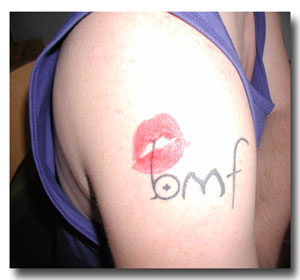:::lotta smooch:::Thursday, June 6, 2002
|
Detox Experiment #1 – Let’s yoga baby: Ayurvedic(pronounced eye-yer-vay-duh) is the world’s oldest recorded healing system orginating in India. Detoxification Each person’s emotional and body type are classified as doshas. vata – air and space elements. You are thin, tall, and wiry with a prominent bone structure and a darkish complexion. Out of balance, vata produces fear and anxiety. 3 to 5 days detoxification is recommended. pitta – fire and water elements. You are of medium frame and weight with defined muscle and a ruddy complexion. Out of balance, pitta can cause ulcers and arouse anger. 5 to 7 days detoxification is recommended. kapha – water and earth elements. You are of larger frame and weight with a pale complexion. Out of balance, kapha leads to greed and envy. 1 to 2 weeks detoxification is recommended. I am a Kapha dosha. Step #1 is a two week fast. The two week Kapha dosha plan: 1. A non sweet vegetable juice fast. Fruit juices and sweet vegetable juices are not used for the first two weeks as sweetness increases waste deposits. 2. Herbal teas containing cardamon, cinnamon, and ginger for digestive fire. 3. Gotu kola and licorice oils in drops to cleanse and nourish the brain. 4. Purgatives on the first day and every three days following to clean the digestive system. Digestive bitters like aloe vera or ginger can be used. 5. Mint or eucalyptus steams to cleanse the lungs. 6. Diaphorectic herbs for sweating. 7. Eight to ten glasses of purified water daily. Extra knowledge: Licorice ( Glycyrrhiza glabra & G.uralensis ) History and uses : Licorice is one of the world’s most widely used medicinal plants. Many people think of it as a flavoring for candy, but in fact most “licorice” sticks sold in this country are flavored with anise oil. Licorice itself was used by the Egyptians, Romans, Greeks and Chinese to treat coughs and chills, and research has shown that it does have expectorant, antiallergic and anti-inflammatory properties. In addition, licorice contains mucilage, a substance that coats and soothes inflamed membranes, and so may be useful for treating ulcers and constipation. Today, licorice is the subject of much study, primarily for it’s active compound glycyrrhizin. This substance produces the herb’s anti-inflammatory and anti-allergic effects. But there is also some evidence that licorice may be useful for preventing and healing gastric ulcers, and it may offer an effective treatment for chronic hepatitis. In addition, licorice extracts stimulate the adrenal glands, and so have been used for patients suffering from Addison’s disease (adrenal insufficiency), a particular boone for those who are allergic to the conventional medication. Further studies have shown licorice to counter the effects of two tumor-producing agents. It may also supress the enzyme that leads to tooth decay from sugar. In general, licorice and it’s extracts are safe for normal use. However, long-term or excessive ingestion can produce serious side effects. Symptoms include headache, lethargy, sodium and water retension, loss of potassium, high blood pressure and possible heart failure. Such reactions, however, are rare, a fact demonstrated by licorice’s widespread use in herbal teas, and as a flavoring in foods and tobacco. Kapha Massage Oil Composition: Base Oils: Almond and Organic Canola What should I expect from an Ayurvedic treatment?[more] Ayurvedic treatment focuses on rebalancing the doshas. A practitioner will take your pulse, observe your tongue, eyes, and physical form, and listen to the tone of your voice. He or she will also ask you questions about your general state of health. Based on this assessment, he or she will then make recommendations on how to restore your natural dosha balance. Practitioners draw from more than 20 types of treatment, but the most commonly prescribed include: Pranayama—breathing exercises. Practicing pranayama generates feelings of calmness. Abhyanga—the practice of rubbing the skin with oil (usually sesame oil) to increase blood circulation and draw toxins out of the body through the skin. Rasayana—the use of mantras (repeated words or phrases) during meditation combined with specific herbs; often prescribed to rejuvenate a person. Yoga—a combination of pranayama, movement, and meditation. Has been shown to improve circulation and digestion, and to reduce blood pressure, cholesterol levels, anxiety, and chronic pain. Panchakarma—a cleansing therapy. Patients are urged to sweat, have bowel movements, and even vomit in an effort to cleanse the body of toxins. Has been shown to reduce cholesterol. Herbal medicines—prescribed to restore dosha balance. For example, an active ingredient in Bishop’s weed fruit (Ammi visnaga), called khellin, can be used to treat asthma. Facial Steams Through perspiration, you eliminate toxins while stimulating circulation. The steam softens your skin while opening up your pores. This helps your skin to absorb the nourishing properties of the herbs. Normal skin: once a week To use: Place a special tea bag( Eucalyptus Leaves, Thyme Leaves, Rosemary Leaves and Peppermint Leaves packed in a muslin bag) in a bowl and pour 6 cups of boiling water over top. Stir briefly with a wooden spoon and let it steep for 10 minutes. While waiting, remove all makeup and clean your face in your usual manner. Make a tent over your head and the bowl with a towel. Then hold your face 12 to 18 inches away. Keep your eyes closed and maintain this position for 10 to 15 minutes. When finished, rinse with tepid to cool water. You can use a diluted herbal vinegar to dab onto your face with absorbent cotton to tighten up your pores. Avoid sudden changes of temperature and don’t go outdoors for an hour or so. Links: Books 225 9:44 PM | This website issued and granted on June 1, 2002. |
© lottasmooch.com ~ post restored on 2/11/2017


